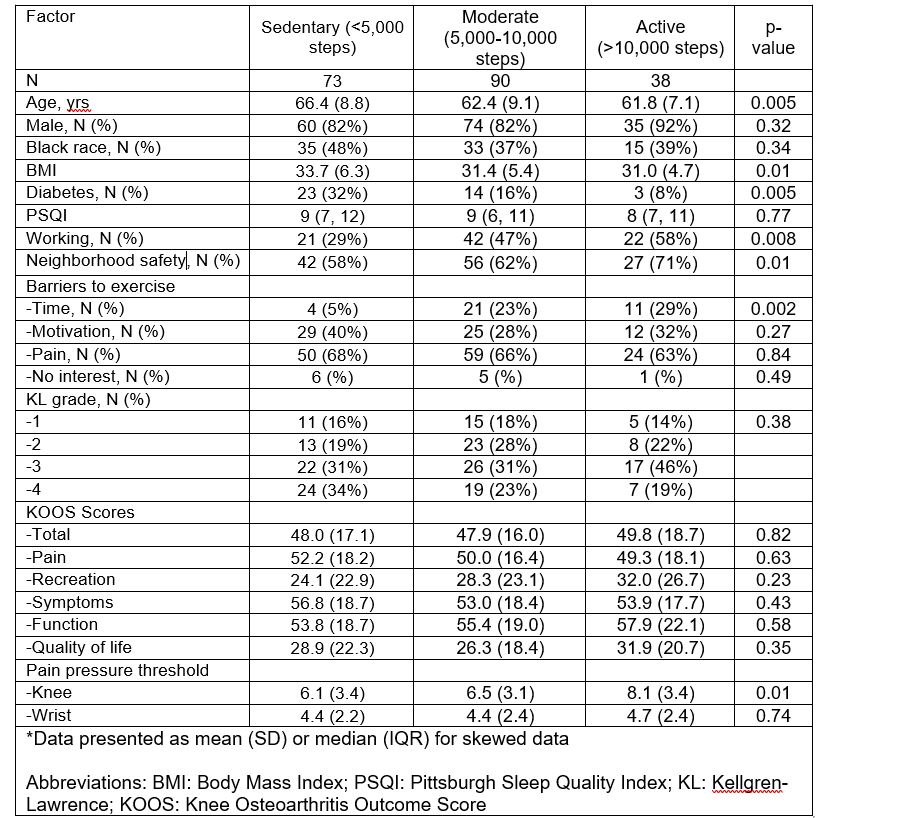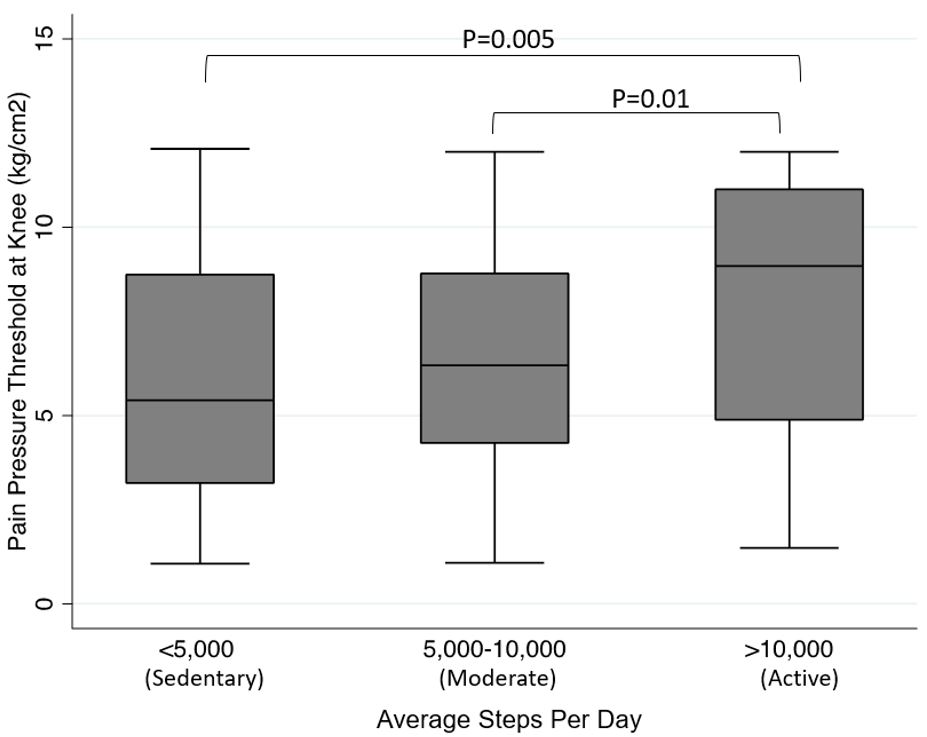Session Information
Session Type: Poster Session C
Session Time: 10:30AM-12:30PM
Background/Purpose: Despite strong recommendations for physical activity in knee osteoarthritis (KOA) clinical practice guidelines, only a small fraction of those with KOA meet guidelines for physical activity with many exhibiting sedentary behavior1. We aimed to identify factors associated with sedentary behavior in Veterans with KOA and evaluate the association between physical activity and pain assessments.
Methods: Data were from the Marching On For VEterans with Osteoarthritis of the Knee (MOVE-OK) trial, a multicenter RCT which aims to determine the effectiveness of a remotely-applied incentive program along with corticosteroid injections for promoting physical activity and reducing symptoms in Veterans with KOA. Participants were ≥40 years of age and had a Kellgren-Lawrence (KL) knee radiograph grade of ≥1. Activity was directly measured using Fitbit activity monitors that recorded daily step counts. This analysis used step counts from a 2 to 6-week run-in period prior to study intervention. Activity levels were categorized as sedentary (< 5000 steps), moderate (5000-10000 steps), and active ( >10000 steps)2. Regional pain sensitization was assessed at the knee and left wrist joints using an algometer. KOA symptoms were self-reported using the Knee Osteoarthritis Outcome Score (KOOS). Univariable and multivariable regression assessed the association between pain assessments and physical activity level controlling for age, sex, BMI, diabetes, working status, and neighborhood safety.
Results: Among 201 Veterans with KOA, 73 (36%) were categorized as sedentary, 90 (45%) as moderately active, and 38 (19%) as physically active [Table 1]. Those who were sedentary were older, had higher BMI and had a higher prevalence of diabetes than the higher activity groups. Veterans who were active were more likely to be working and feel that their neighborhood was safe to walk in than those in lower physical activity groups. While those with lower activity tended to have higher KL-grades, this was not statistically significant. Interestingly, there was no significant difference in pain reported as a barrier to exercise between groups, but instead was the biggest barrier to exercise at similar frequencies across all three groups (68% vs 66% vs 63%). The physically active group had higher pain pressure thresholds at the knee joint than the moderate and sedentary groups (8.1 vs. 6.5 vs 6.1, all p< 0.05) [Figure 1]. In a multivariable model, active group had a significantly higher pain threshold than the sedentary group (β=1.80 [95% CI 0.39, 3.20], p=0.01).
Conclusion: Older age, obesity, and diabetes were associated with sedentary behavior in Veterans with KOA whereas neighborhood safety and current employment were associated with higher physical activity. Physical activity was not associated with self-reported pain but was associated with regional pain sensitization at the knee. These data support interventional studies performed in other settings that have suggested benefits of exercise on pain sensitivity. The ongoing trial will assess whether behavioral interventions and steroid injections can result in improvements in KOA symptoms over time.
1. Wallis JA et al. Osteoarth Cart. 2013
2. Tudor-Locke C et al. Med Sci Sports Exerc. 2008
To cite this abstract in AMA style:
Brubeck H, Azizi D, Wetzel S, Olave M, Gillcrist R, Kramer B, Ateh B, White D, Scanzello C, Neogi T, Ogdie A, England B, Quinones M, Wysham K, Baker J. Patient Characteristics Associated with Objectively-Assessed Physical Activity in Veterans with Knee Osteoarthritis [abstract]. Arthritis Rheumatol. 2024; 76 (suppl 9). https://acrabstracts.org/abstract/patient-characteristics-associated-with-objectively-assessed-physical-activity-in-veterans-with-knee-osteoarthritis/. Accessed .« Back to ACR Convergence 2024
ACR Meeting Abstracts - https://acrabstracts.org/abstract/patient-characteristics-associated-with-objectively-assessed-physical-activity-in-veterans-with-knee-osteoarthritis/


